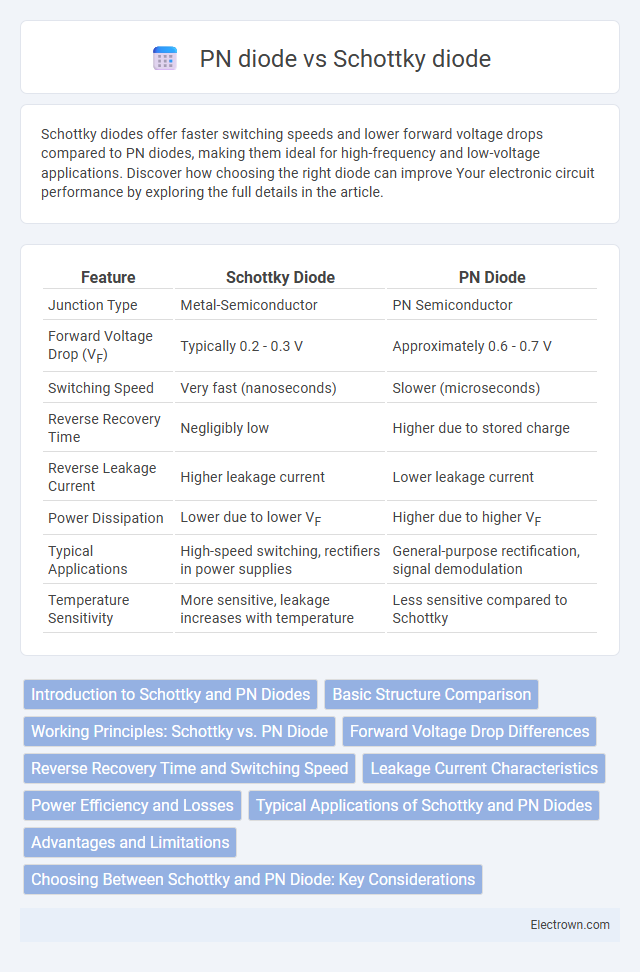Schottky diodes offer faster switching speeds and lower forward voltage drops compared to PN diodes, making them ideal for high-frequency and low-voltage applications. Discover how choosing the right diode can improve Your electronic circuit performance by exploring the full details in the article.
Table of Comparison
| Feature | Schottky Diode | PN Diode |
|---|---|---|
| Junction Type | Metal-Semiconductor | PN Semiconductor |
| Forward Voltage Drop (VF) | Typically 0.2 - 0.3 V | Approximately 0.6 - 0.7 V |
| Switching Speed | Very fast (nanoseconds) | Slower (microseconds) |
| Reverse Recovery Time | Negligibly low | Higher due to stored charge |
| Reverse Leakage Current | Higher leakage current | Lower leakage current |
| Power Dissipation | Lower due to lower VF | Higher due to higher VF |
| Typical Applications | High-speed switching, rectifiers in power supplies | General-purpose rectification, signal demodulation |
| Temperature Sensitivity | More sensitive, leakage increases with temperature | Less sensitive compared to Schottky |
Introduction to Schottky and PN Diodes
Schottky diodes feature a metal-semiconductor junction, resulting in lower forward voltage drop and faster switching speeds compared to PN diodes, which have a p-type and n-type semiconductor junction. The unique construction of Schottky diodes reduces junction capacitance and reverse recovery time, making them ideal for high-frequency and power applications. PN diodes, known for their high reverse voltage tolerance and robust performance, are commonly used in rectification and voltage regulation tasks.
Basic Structure Comparison
Schottky diodes feature a metal-semiconductor junction, resulting in faster switching speeds and lower forward voltage drops compared to PN diodes, which have a traditional p-n junction formed by joining p-type and n-type semiconductor materials. Schottky diodes lack the charge storage effect found in PN diodes, reducing recovery time and improving efficiency in high-frequency applications. Your choice between the two depends on whether low forward voltage and rapid switching or higher voltage blocking capability and reverse recovery are more critical for your circuit.
Working Principles: Schottky vs. PN Diode
Schottky diodes operate based on the metal-semiconductor junction, allowing majority carriers to conduct with minimal charge storage, resulting in fast switching speeds and low forward voltage drop typically around 0.2 to 0.3 volts. In contrast, PN diodes rely on the p-n junction where minority carrier injection and recombination dominate, causing higher forward voltage drops near 0.7 volts and slower recovery times due to charge storage. The absence of minority carrier storage in Schottky diodes enables superior efficiency in high-frequency and low-voltage applications compared to conventional PN junction diodes.
Forward Voltage Drop Differences
Schottky diodes exhibit a significantly lower forward voltage drop, typically ranging from 0.15 to 0.45 volts, compared to PN diodes which usually have a forward voltage drop of 0.6 to 1.7 volts. This lower voltage drop in Schottky diodes results from the metal-semiconductor junction, enabling faster switching speeds and improved efficiency in power-sensitive applications. Understanding this characteristic allows you to select the optimal diode for reducing power loss and heat generation in your electronic circuits.
Reverse Recovery Time and Switching Speed
Schottky diodes exhibit significantly faster switching speeds and much lower reverse recovery times compared to PN diodes due to their majority carrier conduction mechanism. The absence of charge storage in Schottky diodes enables reverse recovery times in the order of nanoseconds, whereas PN diodes typically have reverse recovery times in microseconds because of minority carrier recombination. These characteristics make Schottky diodes ideal for high-frequency and high-speed switching applications.
Leakage Current Characteristics
Schottky diodes exhibit significantly lower leakage current compared to PN diodes due to their metal-semiconductor junction, which reduces charge storage and allows faster switching. Your circuit benefits from reduced leakage currents, making Schottky diodes ideal for high-frequency and low-power applications. In contrast, PN diodes have higher reverse leakage current caused by minority carrier injection across the p-n junction, limiting their efficiency in sensitive electronic circuits.
Power Efficiency and Losses
Schottky diodes provide superior power efficiency compared to PN diodes due to their lower forward voltage drop, typically around 0.2 to 0.3 volts, reducing conduction losses in high-frequency and high-current applications. PN diodes exhibit higher forward voltage drops, usually between 0.6 and 0.7 volts, leading to greater power dissipation and thermal losses under similar operating conditions. Your choice of Schottky diode can enhance energy savings and reduce heat generation, improving overall system efficiency.
Typical Applications of Schottky and PN Diodes
Schottky diodes are commonly used in high-speed switching applications, such as power rectification in switched-mode power supplies, RF signal detection, and clamping circuits due to their low forward voltage drop and fast recovery time. PN diodes are widely utilized in general-purpose rectification, voltage regulation, and signal demodulation where higher reverse voltage tolerance and lower leakage current are essential. The distinct electrical characteristics make Schottky diodes ideal for low voltage, high-frequency circuits, while PN diodes excel in applications requiring robust voltage blocking and stable operation.
Advantages and Limitations
Schottky diodes offer faster switching speeds and lower forward voltage drop (typically 0.2-0.3V) compared to PN diodes, making them ideal for high-frequency and low-voltage applications. However, Schottky diodes have higher reverse leakage current and lower maximum reverse voltage ratings than PN diodes, limiting their use in high-voltage circuits. PN diodes provide better thermal stability and higher reverse breakdown voltage, suitable for power rectification but with slower switching and higher forward voltage drop (around 0.7V).
Choosing Between Schottky and PN Diode: Key Considerations
Choosing between a Schottky diode and a PN diode depends on factors like switching speed, forward voltage drop, and reverse leakage current. Schottky diodes offer faster switching and lower forward voltage (typically 0.2 to 0.3 V), making them ideal for high-frequency and power-sensitive applications. Your decision should consider the specific circuit requirements, as PN diodes provide better reverse voltage ratings and lower leakage current for applications needing higher voltage tolerance.
Schottky diode vs PN diode Infographic

 electrown.com
electrown.com